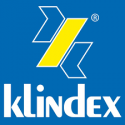TECHNIQUE FOR POLISHING GRANITE FLOORS
Granite is a special stone resulting out of Igneous Rock and generally from deep under ground where heat and temperature are maximum. The stone under heat & pressure conditions has melted minerals, evaporated water and sometimes ignited to form a hard crystalline igneous rock. The darker the stone the harder it is. Grinding and polishing this rock takes special process including heavier weight (110 kg to 140 kg), higher rpm (600 to 1300 rpm), and special lead based grinding and polishing tools (preferable heavy head grinder with planetary head for generating higher rpm to generate heat.)
The process starts with grinding the lippage around joints, damaged and pitted surface of floor. The entire pitted floor might need to be ground up to 5 mm which is a very tedious process can be undertaken using Klindex Heavy Grinders (Variable speed option is a great help), with Planetary, special Klindex Metal Grits meant for this purpose. Each Grinding process involves repairs and fillers for fine repairs. Filling is done using DM Hardener which hardens the surface of floor and make this water repellant to about 70 % to cover for evaporation of water. The Full Epox based Filler is used to fill minor pin holes. This process requires 8 – 36 hours to set and dry depending upon kind of resin used.

Worst Areas in Floor. 
Starts wearing & surface wears off 
Floor Condition Before Start – Planetary Levighetor 640 TP VS 
Metal Process to Grind and Level GS 1 
Remove Scratches with GS 2 
After GS 3, Use resin Jumper red Green Grit 60 
Jumper Red Black Grit 120 
After using Full Epox 1150 (special Epoxy clear) 
Re – hone with Jumper Red Yellow Grit 400 
Check for pinhole and hone with Jumper Red White Grit 800 
After 24 hour of Beton Hardener application, Use Jumper Red Blue Grit 1500. 
Run Jumper Red Grey Grit 3500 to get floor 
Polish with Polish KG (for dark Granite) 
Buff till clear shine is achieved. 
Use Kristal Blue to get wet look and ANTI SKID finish on floor. 
Final Finish 
Water Resistant & Anti Skid
Grinding & Polishing Process
- Start with Metal Grit GS 0 for lippage > 5 mm
- Start with Metal Grit GS 1 for lippage < 5 mm
- Use Full Stukko for filling open joints & Cracks
- Proceed to Metal Grit GS 2
- Proceed with Metal Grit GS 3
- Check and re-grout all joints and cracks using liquid/ color / transparent stukko to match colour. 2 shade darker stukko to be used as stone loses its color after grinding.
- Remove Stukko using Cyclon Red Grit 3. To save diamond from wearing off on Stukko you can use Pavelux Or Jumper Black for removal. using Pavelux 3 or Jumper Black 3
- Continue to Cyclon Red 4 to further remove excess grout and to remove scratch marks.
- Stones have different porosities in different areas. To get uniform Surface Abrasion Beton DM Densifier should be used. This will harden inside the stone and will enhance Surface Abrasion. Also it will prevent cracking on Brittle Stones. Mix DM Beton Hardner in 1:4 with water and wash the floor for 1 hour. Leave for 24 hours before proceeding further.
- Hone further with Cyclon Red 5, 6. Check for color. should be back. if not then some or the other grit has not been run properly or too much water has been used. proper heat, proper cooling, proper time is the key. Special color dyes are available in Klindex range to re-colour or change shade.
- Hone further with Cyclon Red 7 & 8.
- For more darker expensive marble continue Cyclon Red 9.
- Use Polish KG powder for DARK STONE to attain high & uniform gloss.
- Use Polish KG Clear for LIGHT Stones.
- Use KORRECTOR to enhance / darken colour.
After having finish, seal the floor with sealing cum waterproofing agent called KI WATER PROOFING in case the stone is porous in nature. This is a Solvent based Water & Stain Repellent Sealer. It is applied with Piece of cotton or White pad with machine. It is spread all over the floor. Floor is left for at least Six (6) hours. After this floor is buffed with white pad. Usually 2 – 3 coats are required to completely seal the floor. CAUTION – In case of usage of Kristal BLU, it is to be used BEFORE KRISTAL BLU.
ANTIKE, a special ageing, water & stain resistant sealer can also be used to provide Darkened AGEING effect.


